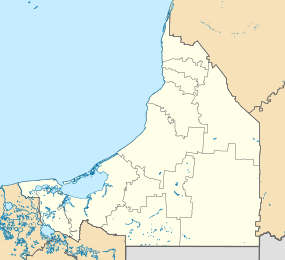වැලරියානා (නගරය)
| ඛණ්ඩාංක | 18°54′9″N 89°19′3″W / 18.90250°N 89.31750°Wඛණ්ඩාංක: 18°54′9″N 89°19′3″W / 18.90250°N 89.31750°W |
|---|---|
| ඉතිහාසය | |
| යුග | Late Preclassic to Late Classic |
| සංස්කෘතීන් | මායා ශිෂ්ටාචාරය |
වැලරියානා යනු ක්වින්ටනා රූ ප්රාන්තයට මායිම්ව පිහිටි මෙක්සිකෝවේ කැම්පේචේ ප්රාන්තයේ පැරණි මායා නගරයකි.[1] එහි සොයාගැනීම 2024 ඔක්තෝම්බර් මාසයේදී ප්රකාශයට පත් කරන ලද අතර, එම ස්ථානයට යාබද විලක නමින් නම් කරන ලදී.[2]
විස්තරය
[සංස්කරණය]ශෛලිය සහ ගෘහනිර්මාණ ශිල්පය ගිනිකොන දෙසින් ඇති චැක්ටුන් - ටැම්චෙන් ප්රදේශයට ගැලපේ.[3] නගරයේ බහු ප්ලාසා, පන්සල් පිරමිඩ, මායා බෝල්ගේම් උසාවිය සහ වේලි සහිත ජලාශයක් අඩංගු වන අතර ඒවා දේශපාලන අගනුවරක් පෙන්නුම් කරයි.[3] පර්යේෂකයන් ඇස්තමේන්තු කරන්නේ මෙම වෙබ් අඩවියේ ව්යුහයන් 6,500කට අධික සංඛ්යාවක් අඩංගු බවයි.[4] මෙම වෙබ් අඩවිය 50 square miles (130 km2)[4]
"ඊ-කණ්ඩායම් එකලස් කිරීම" ලෙස හැඳින්වෙන විශේෂිත වාස්තුවිද්යාත්මක ලක්ෂණ පෙන්නුම් කරන්නේ ආරම්භක දිනය ක්රි.ව. 150 ට පෙර (ප්රාග් සම්භාව්ය යුගයේ) සහ මායා ශිෂ්ටාචාරයේ සම්භාව්ය යුගයේ දී නගරය සමෘද්ධිමත් විය හැකි බවයි ආ. 250 – ආ. 900 CE).[5][6] වැලරියානාහි ගොඩ නැගීමේ පොකුරු ඝනත්වය කැලැක්මුල් වලට පමණක් දෙවැනි වන බව පර්යේෂකයන් විසින් සලකනු ලැබේ. ක්රිස්තු වර්ෂ 750 සිට 850 දක්වා එහි උච්චතම අවස්ථාව වන විට 30,000 ත් 50,000 ත් අතර ජනගහනයක් ඔවුන් ගණන් බලා ඇත.[7]
සොයාගැනීම
[සංස්කරණය]මායා ශිෂ්ටාචාරයේ සම්භාව්ය යුගයේ දී Xpujil අවට ප්රදේශය ජනාකීර්ණ වූ අතර ඉංජිනේරුමය වශයෙන් නිර්මාණය වූ බව 1970 ගණන්වල සිට පර්යේෂකයන් දැන සිටි නමුත් එම ප්රදේශය පිළිබඳ පුරාවිද්යාත්මක පරීක්ෂණ හිඟ වී ඇත.[8]
උතුරු ඇරිසෝනා විශ්ව විද්යාලය, ටියුලේන් විශ්ව විද්යාලය, හූස්ටන් විශ්ව විද්යාලයේ ගුවන් ලේසර් සිතියම්ගත කිරීමේ ජාතික මධ්යස්ථානය සහ මානව විද්යාව හා ඉතිහාසය පිළිබඳ ජාතික ආයතනය යන පර්යේෂකයන් විසින් වැලරියානා සොයා ගැනීම සිදු කරන ලදී.[9][10] ඔවුන් ලයිඩර් දත්ත භාවිතා කළේ, වනාන්තර ආවරණය හරහා ඉහළ විභේදන භූමි දත්ත නිපදවන ලයිඩර් නිසා,[11] එය අතීතයේ වෙනත් නොදන්නා මායා අඩවි සොයා ගැනීමට භාවිතා කර ඇත. කෙසේ වෙතත්, එය මිල අධික වූ බැවින්, මෙම පර්යේෂකයන් විසින් නේචර් කන්සර්වන්සි හි මෙක්සිකානු ශාඛාව විසින් 2013 වනාන්තර අධීක්ෂණ ව්යාපෘතියකින් පෙර පැවති ලිඩා දත්ත භාවිතා කරන ලදී.[9][12] පර්යේෂකයන් වැඩිදුර ක්ෂේත්ර කටයුතු සැලසුම් කරයි,[12] නටබුන් විස්තර කරන්නේ "පැහැදිලි පෙනෙන පරිදි සැඟවී ඇති" ලෙසිනි, Xpujil සහ වගා කරන ලද ගොවිබිම් අසල ෆෙඩරල් අධිවේගී 186 සිට මිනිත්තු 15 ක් පමණි.[13][10]
පර්යේෂකයන් එය "වැලරියානා" ලෙස නම් කර ඇත, අසල වැවක්, "Laguna La Valeriana", [14] කුඩු ජාවාරම්කරුවන් විසින් ගුවන් පථයක් ලෙස භාවිතා කරන ලද වියළි ඇඳ.[15]
මූලාශ්ර
[සංස්කරණය]- ^ Weisberger, Mindy (2 November 2024). "Lost Maya city discovered in Mexico". CNN. 2 November 2024 දින මුල් පිටපත වෙතින් සංරක්ෂණය කරන ලදී. සම්ප්රවේශය 2 November 2024.
- ^ Auld-Thomas, Luke; Canuto, Marcello A.; Morlet, Adriana Velázquez; Estrada-Belli, Francisco; Chatelain, David; Matadamas, Diego; Pigott, Michelle; Fernández Díaz, Juan Carlos (29 October 2024). "Running out of empty space: environmental lidar and the crowded ancient landscape of Campeche, Mexico". Antiquity (ඉංග්රීසි බසින්). 98 (401): 1340–1358. doi:10.15184/aqy.2024.148. ISSN 0003-598X.
- ^ a b Auld-Thomas, Luke; Canuto, Marcello A.; Morlet, Adriana Velázquez; Estrada-Belli, Francisco; Chatelain, David; Matadamas, Diego; Pigott, Michelle; Fernández Díaz, Juan Carlos (29 October 2024). "Running out of empty space: environmental lidar and the crowded ancient landscape of Campeche, Mexico". Antiquity (ඉංග්රීසි බසින්). 98 (401): 1340–1358. doi:10.15184/aqy.2024.148. ISSN 0003-598X.
- ^ a b Anderson, Sonja (2024-10-29). "'Found' Dataset Reveals Lost Maya City Full of Pyramids and Plazas, Hiding in Plain Sight Beneath a Mexican Forest". Smithsonian Magazine. සම්ප්රවේශය 2024-11-02.
- ^ Auld-Thomas, Luke; Canuto, Marcello A.; Morlet, Adriana Velázquez; Estrada-Belli, Francisco; Chatelain, David; Matadamas, Diego; Pigott, Michelle; Fernández Díaz, Juan Carlos (29 October 2024). "Running out of empty space: environmental lidar and the crowded ancient landscape of Campeche, Mexico". Antiquity (ඉංග්රීසි බසින්). 98 (401): 1340–1358. doi:10.15184/aqy.2024.148. ISSN 0003-598X.
- ^ Anderson, Sonja (2024-10-29). "'Found' Dataset Reveals Lost Maya City Full of Pyramids and Plazas, Hiding in Plain Sight Beneath a Mexican Forest". Smithsonian Magazine. සම්ප්රවේශය 2024-11-02.
- ^ Rannard, Georgina (2024-10-28). "Lost Mayan city found in Mexico jungle by accident". BBC News (බ්රිතාන්ය ඉංග්රීසි බසින්). සම්ප්රවේශය 2024-10-29.
- ^ Auld-Thomas, Luke; Canuto, Marcello A.; Morlet, Adriana Velázquez; Estrada-Belli, Francisco; Chatelain, David; Matadamas, Diego; Pigott, Michelle; Fernández Díaz, Juan Carlos (29 October 2024). "Running out of empty space: environmental lidar and the crowded ancient landscape of Campeche, Mexico". Antiquity (ඉංග්රීසි බසින්). 98 (401): 1340–1358. doi:10.15184/aqy.2024.148. ISSN 0003-598X.
- ^ a b Anderson, Sonja (2024-10-29). "'Found' Dataset Reveals Lost Maya City Full of Pyramids and Plazas, Hiding in Plain Sight Beneath a Mexican Forest". Smithsonian Magazine. සම්ප්රවේශය 2024-11-02.
- ^ a b Radley, Dario (29 October 2024). "Lasers uncover lost Maya city in Mexico, revealing thousands of previously unknown structures". Archaeology News. සම්ප්රවේශය 2 November 2024.
- ^ Auld-Thomas, Luke; Canuto, Marcello A.; Morlet, Adriana Velázquez; Estrada-Belli, Francisco; Chatelain, David; Matadamas, Diego; Pigott, Michelle; Fernández Díaz, Juan Carlos (29 October 2024). "Running out of empty space: environmental lidar and the crowded ancient landscape of Campeche, Mexico". Antiquity (ඉංග්රීසි බසින්). 98 (401): 1340–1358. doi:10.15184/aqy.2024.148. ISSN 0003-598X.
- ^ a b Jones, Sam (29 October 2024). "Lost Maya city with temple pyramids and plazas discovered in Mexico". The Guardian (බ්රිතාන්ය ඉංග්රීසි බසින්). ISSN 0261-3077. සම්ප්රවේශය 29 October 2024.
- ^ Rannard, Georgina (2024-10-28). "Lost Mayan city found in Mexico jungle by accident". BBC News (බ්රිතාන්ය ඉංග්රීසි බසින්). සම්ප්රවේශය 2024-10-29.
- ^ Auld-Thomas, Luke; Canuto, Marcello A.; Morlet, Adriana Velázquez; Estrada-Belli, Francisco; Chatelain, David; Matadamas, Diego; Pigott, Michelle; Fernández Díaz, Juan Carlos (29 October 2024). "Running out of empty space: environmental lidar and the crowded ancient landscape of Campeche, Mexico". Antiquity (ඉංග්රීසි බසින්). 98 (401): 1340–1358. doi:10.15184/aqy.2024.148. ISSN 0003-598X.
- ^ "Eran dos narcoaeródromos" (ස්පාඤ්ඤ බසින්). Por Esto Online. 29 June 2019.


